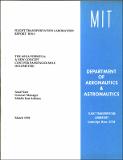| dc.description.abstract | The demand for air transport is affected by the usual extraneous factors, demographic, social and economic, as well as those falling properly within the sphere of the industry itself such as the quality of service, safety, .reliability, punctuality, speed, frequency comfort, price. But whatever the overall volume of the demand thus determined, it will not be evenly distributed. There will always be fluctuations in the demand for the individual flights. This emphasis on the individual flight is simply a reflection of the nature of scheduled air transport and of the indivisibility of the air transport vehicle. Obviously, the use of averages would reduce the magnitude of demand fluctuations and would therefore make any analysis correspondingly less meaningful. The fluctuations in individual flight demand have wide ranging effects on several aspects of the Air Transport Industry such as scheduling, optimum size of aircraft, frequency and capacity, price elasticity and the determination of fares, etc. It will thus be observed that airlines tend to offer a level of capacity falling between the extreme values of demand, high and low. They almost never choose to operate an aircraft with a capacity sufficient to satisfy the demand for each and every flight. Equally, they are most unlikely to operate, continuously, on the basis of a virtually full aircraft. In the first case, i.e. if the airline were to operate an aircraft sufficiently large as to cater for the highest demand levels, then it would be offering excessive capacity on most remaining flights. This would mean lower average load factors and lower profitability. Such consequences are not only harmful to the airline itself but, also, to the public, as lower load factors and lower profitability will necessarily mean that fares will be maintained at a higher level than would have been possible otherwise. In the second case, i.e. where the airline is aiming at a continuous operation with a very high load factor, (say above 90%), there will be very few flights in respect of which the demand is totally satisfied by the capacity offered. On all the remaining flights, and they are the vast majority, there will be more passengers than seats, which means that certain numbers of passengers will be turned away, i.e. there will be frequent flights with overflows, some of substantial proportions. These will cause public dissatisfaction and outcry of such intensity as to harm the development of the industry and, probably, bring 3 about the intervention of regulatory authorities. Furthermore, the airline would not be maximizing its profits, since, at such load factors, as will be shown later, total profits can be increased by operating an aircraft with a greater seating capacity. Airline managements are therefore required to determine that level of capacity which, given the specific volume and fluctuations of demand on a particular route or segment, produces the optimum compromise between the above constraints. Another consequence of the fluctuations in the demand for individual flights relates to price elasticity and the determination of fares. On the basis that the demand for air transport is price elastic, the increase in demand, resulting from a given reduction in price, cannot be fully satisfied by the airline because of the fluctuations in individual flight.demand. Also, the airline itself cannot achieve the full increase in revenue indicated by the price elasticity. | en_US |
